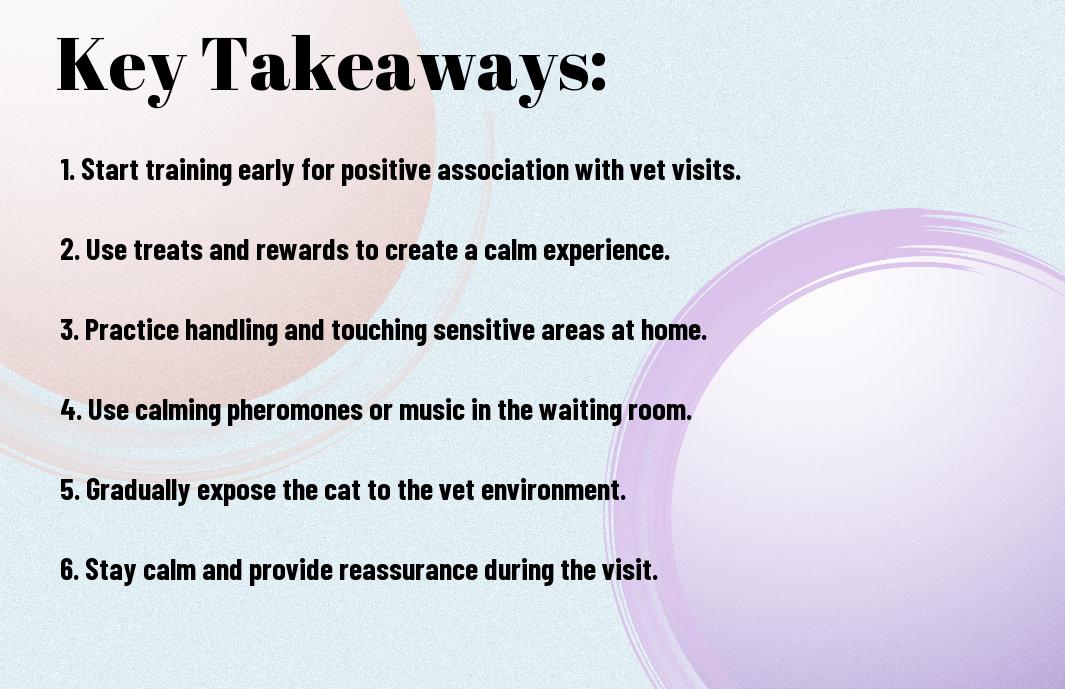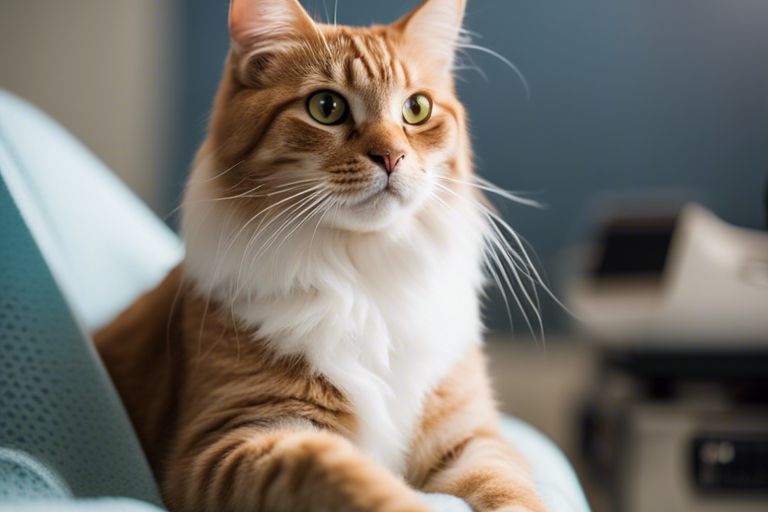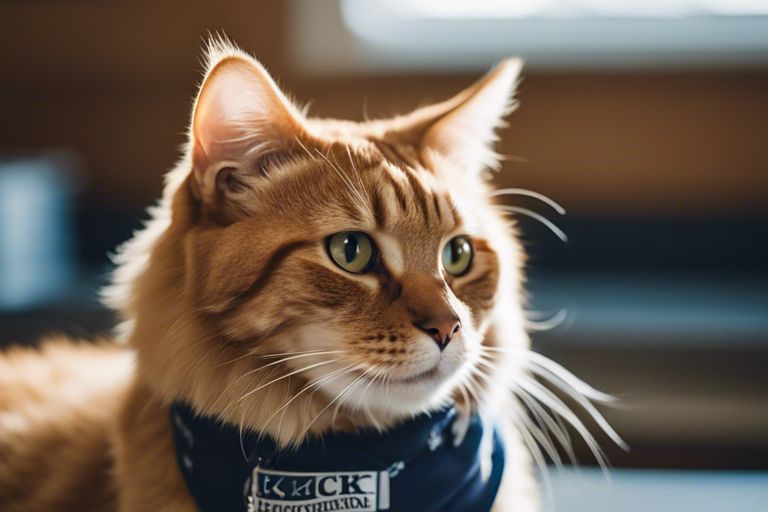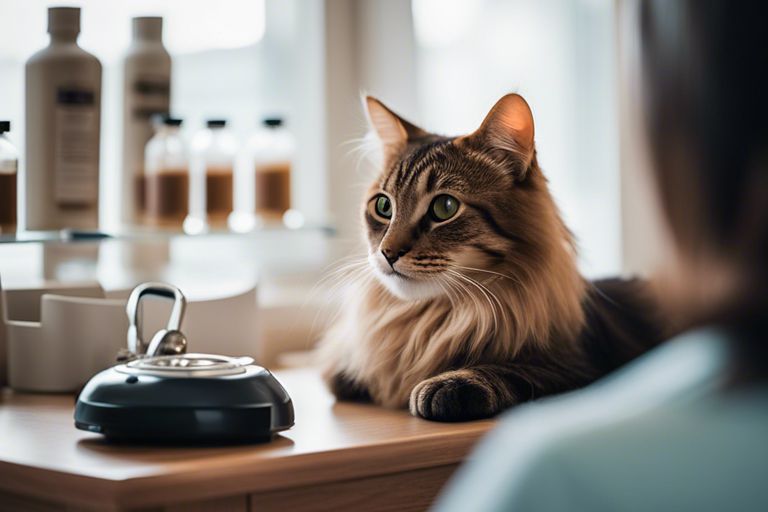Calming a naturally anxious cat during vet visits can be a challenging task, but with the right strategies and techniques, you can help your feline friend stay calm and comfortable. Stress and anxiety can not only make the visit more difficult for your cat, but it can also be dangerous for their health. In this blog post, we will explore some effective strategies for training your cat to stay calm during vet visits, ensuring a smoother and safer experience for both you and your pet.
Key Takeaways:
- Positive reinforcement: Use treats and praise to reward calm behavior during vet visits.
- Gradual desensitization: Introduce your cat to the carrier and car rides slowly to prevent anxiety.
- Familiar scents: Bring a familiar blanket or towel to the vet to comfort your cat.
- Calming pheromones: Use diffusers or sprays containing feline pheromones to promote relaxation.
- Professional guidance: Consult with a veterinarian or animal behaviorist for personalized training strategies.
 Understanding Cat Behavior
Understanding Cat Behavior
The behavior of cats is complex and can be influenced by a variety of factors including their environment, past experiences, and genetics. Understanding your cat’s behavior is key to helping them stay calm during vet visits. Cats are known for their independent nature and may become stressed or anxious in unfamiliar situations, such as a trip to the vet. By understanding their behavior, you can better prepare them for the experience and help them stay calm.
Recognizing Stress Signals in Cats Before Vet Visits
Before a vet visit, it’s important to recognize the stress signals that your cat may exhibit. Some common signs of stress in cats include dilated pupils, excessive grooming, hiding, hissing, or aggressive behavior. Pay attention to your cat’s body language and vocal cues, as they may indicate that they are feeling anxious or overwhelmed. By recognizing these signals, you can take steps to help your cat feel more at ease before and during their vet visit.
The Influence of Past Experiences on Your Cat’s Behavior
It’s important to consider your cat’s past experiences when preparing them for a vet visit. If your cat has had negative experiences with vet visits in the past, they may have developed a fear or aversion to the experience. On the other hand, if your cat has had positive experiences, they may be more relaxed and comfortable during their visit. Understanding your cat’s past experiences can help you tailor your approach to training them to stay calm during vet visits. By addressing any negative experiences and building positive associations, you can help your cat feel more at ease.
Preparing Your Cat for Vet Visits
After learning about the importance of keeping your cat calm during vet visits, it’s time to prepare your feline friend for the experience. Here are some strategies to help familiarize your cat with the process and reduce their stress levels.
First, consider familiarizing your cat with their carrier and the transport process. You can learn more about this by reading the blog post 6 Ways to Make Your Cat’s Vet Visit Less Stressful. This resource can provide helpful tips on making the carrier a comfortable and safe space for your cat, as well as tips on how to acclimate your cat to the car ride to the vet.
Familiarization Strategies with Carriers and Transport
It’s important to introduce your cat to their carrier gradually and make it a positive experience. You can start by leaving the carrier open in a familiar, comfortable space in your home, allowing your cat to explore it at their own pace. Placing familiar bedding or toys inside can help create a sense of security and comfort. Additionally, you can use treats or toys to encourage your cat to enter the carrier voluntarily, reinforcing positive associations with the space.
Positive Association Techniques
Positive association techniques can also be beneficial in preparing your cat for vet visits. You can start by creating positive experiences with the carrier and car rides by offering treats, praise, and playtime. This can help your cat associate these experiences with positive emotions, making them more comfortable and less anxious during transport. Additionally, using pheromone sprays or diffusers, such as Feliway, can help create a calming environment for your cat during travel and vet visits.
By taking the time to familiarize your cat with the carrier and transport process, as well as using positive association techniques, you can help reduce their stress and anxiety associated with vet visits. This can ultimately lead to a more positive experience for both you and your feline companion.

During the Vet Visit
However, when it comes to the actual vet visit, it’s important to remain calm and in control so that your cat feels safe and secure. You are your cat’s advocate and their source of comfort, so your demeanor and actions can have a significant impact on how they react to the vet visit.
Calming Tactics to Use at the Vet’s Office
During the vet visit, try using calming pheromone sprays or wipes designed for cats to help create a sense of calm in the waiting area or examination room. Minimize loud noises and sudden movements that can startle your cat, and try to keep the environment as peaceful as possible. Speak to your cat in a soothing voice and provide gentle reassurance to help them stay calm.
Handling and Comforting Your Cat
When handling your cat at the vet’s office, use a calm and gentle approach to minimize stress and anxiety. Talk to your cat in a soothing tone and use slow, deliberate movements to handle them during the examination. Offer comfort and reassurance by petting them and providing gentle praise to reinforce positive behavior.
Training and Behavioral Modification
Despite the common misconception that cats cannot be trained, it is possible to teach your feline friend to stay calm during vet visits through training and behavioral modification techniques. By understanding your cat’s behavior and utilizing the right strategies, you can help them feel more at ease and reduce their anxiety when visiting the veterinarian.
Desensitization and Counter-Conditioning Methods
Desensitization and counter-conditioning are effective methods for reducing your cat’s anxiety towards vet visits. This involves gradually exposing your cat to the various stimuli associated with vet visits, such as the carrier, car rides, and the vet’s office, in a controlled and positive manner. By pairing these stimuli with positive experiences, such as treats and playtime, you can help your cat form new, more positive associations. This can help reduce their fear and anxiety over time, making vet visits less stressful for both you and your cat.
Professional Training Support for Persistent Anxieties
If your cat continues to exhibit persistent anxiety or fear during vet visits, seeking professional training support can be beneficial. A certified animal behaviorist or trainer can assess your cat’s behavior and develop a personalized training plan to address their specific anxieties. They can provide you with expert guidance and support to help your cat feel more comfortable and relaxed during vet visits. Additionally, professional trainers can teach you effective techniques for managing your cat’s anxiety and improving their overall behavior.

Strategies for Training Your Cat to Stay Calm During Vet Visits
Now that you have learned about various strategies for training your cat to stay calm during vet visits, it’s important to remember that consistency and positive reinforcement are key. By gradually exposing your cat to the carrier and car rides, using calming pheromones, and practicing gentle handling at home, you can help prepare your cat for a more relaxed experience at the vet. Additionally, working with a veterinarian who is experienced in handling anxious cats can provide further support and guidance. With patience and persistence, you can help ensure that your cat stays calm and comfortable during their next vet visit.
FAQ
Q: What are some strategies for training a cat to stay calm during vet visits?
A: There are several strategies you can use to help your cat stay calm during vet visits. First, start by getting your cat comfortable with their carrier. Leave the carrier out in a room they frequent and occasionally place treats or toys inside to encourage them to explore. Gradually increase the time they spend in the carrier. You can also use pheromone sprays or calming collars to help reduce anxiety. Additionally, consider using positive reinforcement by rewarding your cat with treats or praise when they remain calm during practice visits to the vet’s office.
Q: How can I reduce my cat’s stress during car rides to the vet?
A: To reduce your cat’s stress during car rides to the vet, start by getting them used to the car. Take short trips around the block and gradually increase the length of the rides. Consider using a comfortable and secure cat carrier, and line it with familiar bedding or clothing with your scent. You can also cover the carrier with a towel or blanket to minimize visual stimuli. Play calming music in the car to help reduce anxiety. Additionally, schedule the vet visit at a time when the clinic is less busy to minimize your cat’s exposure to other animals and stress triggers.
Q: What should I do if my cat becomes anxious or aggressive at the vet’s office?
A: If your cat becomes anxious or aggressive at the vet’s office, remain calm and speak soothingly to them. Follow the guidance of the veterinary staff as they are trained in handling anxious animals. Avoid scolding or punishing your cat, as this can escalate their anxiety. Consider using a towel or blanket to cover your cat’s carrier, providing them with a sense of security. You can also ask the vet about using sedatives or anti-anxiety medications to help your cat remain calm during visits. It’s important to address your cat’s anxiety with patience and understanding, and consult with your vet for additional support if needed.

Jayley, a devoted cat enthusiast, also writer for other cat blog as well. She aims to dedicated to providing comprehensive information, insights, and advice on everything you’d ever want to know about our whiskered companions.
